专题07 介词(课件)-2024年小升初英语复习讲练测(全国通用版)(共40张PPT)
文档属性
| 名称 | 专题07 介词(课件)-2024年小升初英语复习讲练测(全国通用版)(共40张PPT) |  | |
| 格式 | pptx | ||
| 文件大小 | 37.2MB | ||
| 资源类型 | 试卷 | ||
| 版本资源 | 通用版 | ||
| 科目 | 英语 | ||
| 更新时间 | 2024-06-11 10:01:13 | ||
图片预览

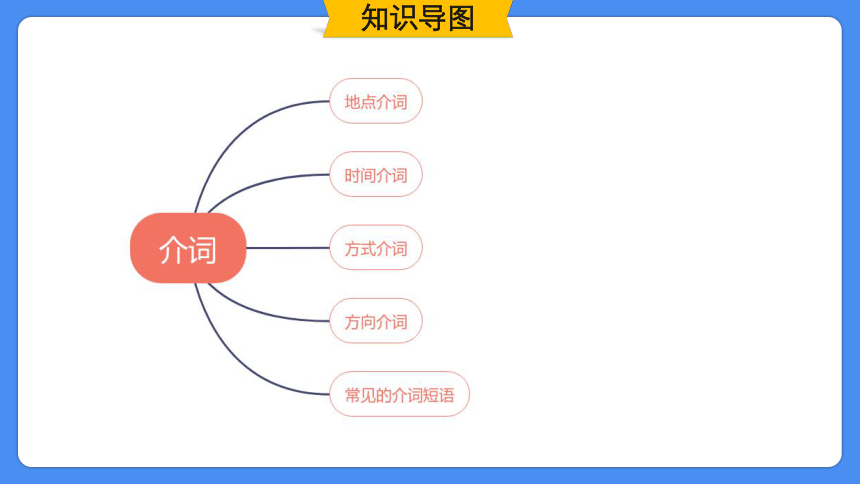
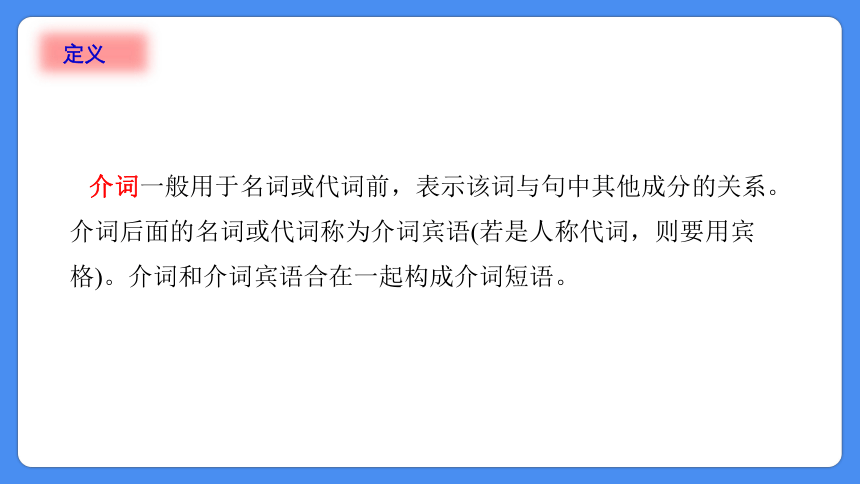
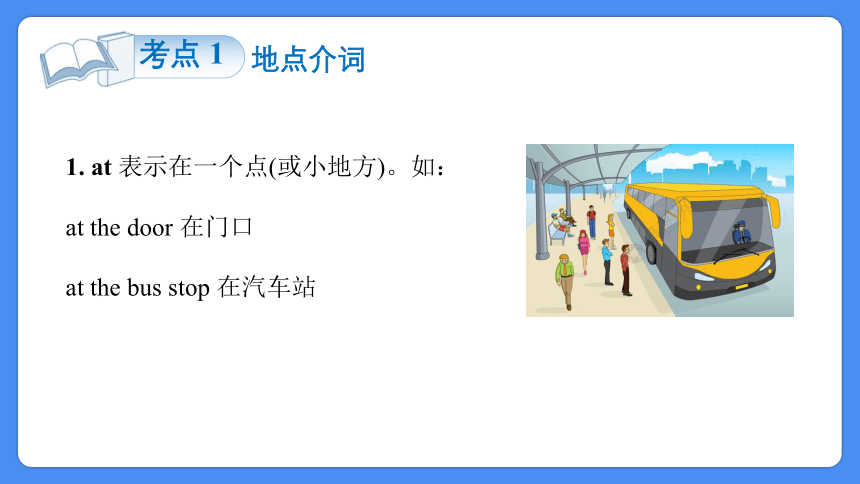
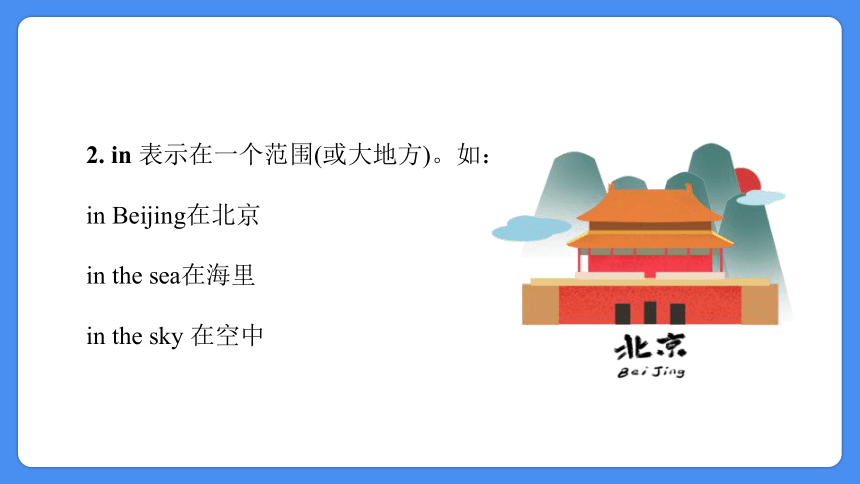
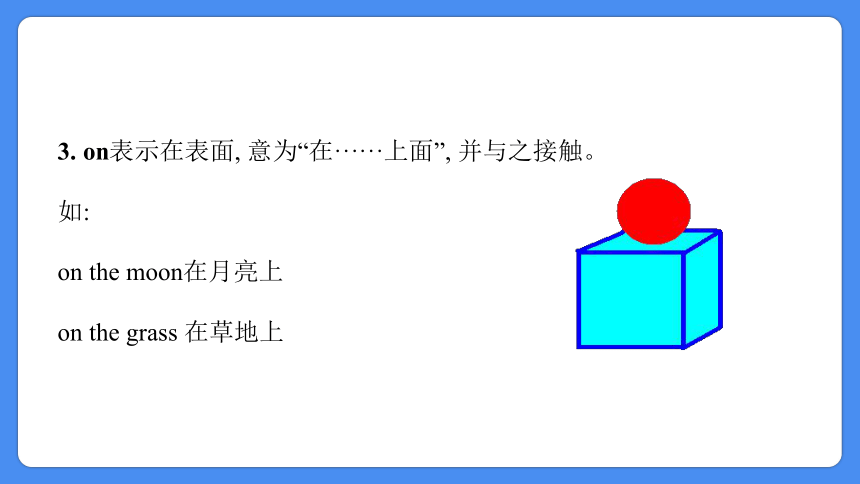


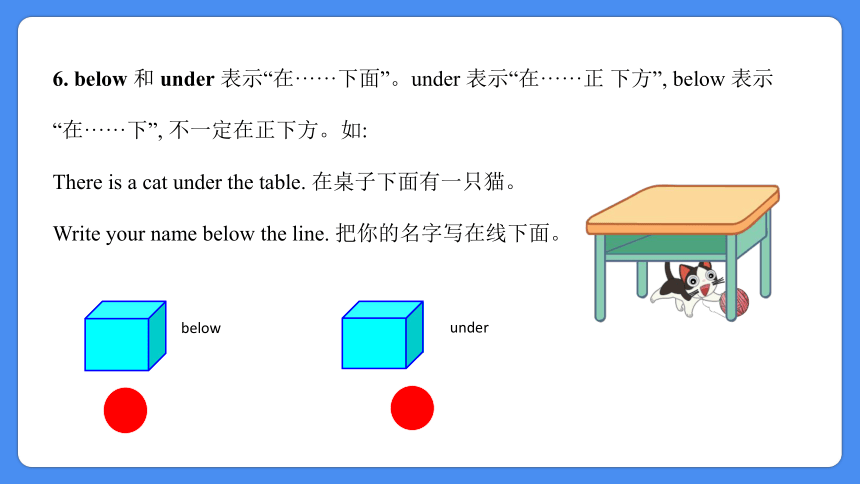

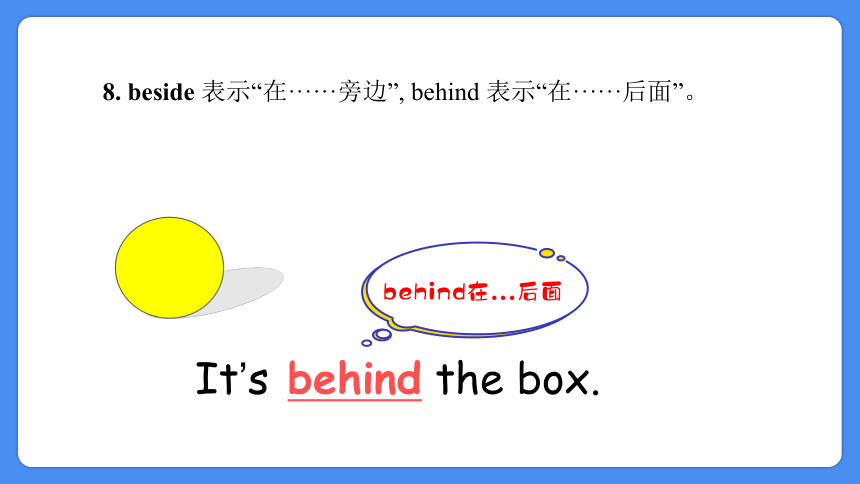

文档简介
(共40张PPT)
第七讲 介词授课人:小升初英语专题复习知识导图
介词一般用于名词或代词前,表示该词与句中其他成分的关系。介词后面的名词或代词称为介词宾语(若是人称代词,则要用宾格)。介词和介词宾语合在一起构成介词短语。
定义
地点介词
考点 1
1. at 表示在一个点(或小地方)。如:
at the door 在门口
at the bus stop 在汽车站
2. in 表示在一个范围(或大地方)。如:
in Beijing在北京
in the sea在海里
in the sky 在空中
3. on表示在表面, 意为“在······上面”, 并与之接触。如:
on the moon在月亮上
on the grass 在草地上
above
4. above指“在 上方”, 不与之接触, 不强调是否垂直, 与 below相对。如:
The bird is flying above my head. 鸟在我的头上飞。
over
5. over指垂直的上方,与 under相对。over指与物体之间有一定的空间,不直接接触。如:
There is a bridge over the river.
在小河的上方有一座桥。
below
under
6. below 和 under 表示“在······下面”。under 表示“在······正 下方”, below 表示“在······下”, 不一定在正下方。如:
There is a cat under the table. 在桌子下面有一只猫。
Write your name below the line. 把你的名字写在线下面。
7. in front of 和 in the front of 表示“在······前面”。
v in front of 指一物在另一物之前,两者互不包括。其反义词是behind (在······的后面)。如:
There are some flowers in front of the house. 房子前面有些花卉。
v in the front of 即一物在另一物范围内的前部。反义词组是 at the back of (在……范围内的后部)。如:
Our teacher stands in the front of the classroom.
我们的老师站在教室前部。(老师在教室里)
It’s behind the box.
behind在...后面
8. beside 表示“在······旁边”, behind 表示“在······后面”。
典例分析
看图,在横线上填写适当的介词。
1.—Where's the ball —It's ________ the box.(见图1)
2.—Where’s the ball —It’s ________ the box.(见图2)
3.—Where's the ball —It's ________ the box.(见图3)
思路点拨:1.表示“在……里面”,指一物体在另一物体的内部,用介词in。2.表示“在……上面”,指一物体在另一物体的上面,两个物体接触,用介词on。3.表示“在……下面”,指一物体在另一物体的正下方,用介词under。
答案1.in 2.on 3.under
3. A:Where ________the pencils
B:I don’t know. Are they ________ the________
A:Yes, they are.
2. A:Where's the ________ ________ it on your desk
B:No, it's ________ the chair.
[过关训练1] 一、根据图片提示,补全句子。
1. A:Where ________ the keys
B:They're ________the ________.
典例分析
are
on
table/desk
book
Is
under
are
in
schoolbag
典例分析
C
C
on
in
二、选出错误的选项,并在横线上改正。
( ) 1. There are two kites in the wall. ________
A B C
( ) 2. You have to stay on bed. ________
A B C
at (1)钟点:at three o’clock 在3点钟
(2)用餐:at lunch time 在午餐时间
(3)节日:at Spring Festival 在春节
(4)年龄:at the age of… 在······岁时
(5)时间:at this time of year 每年此时
(6)一天中的某段时间:at night 在晚上
时间介词
考点 2
表示时间的介词主要有at、on和 in,它们的常见用法如下:
on (1)某一天的某时段:on Sunday afternoon 在星期天下午
(2)星期几:on Monday 在星期一
(3)日期:on May 1st 在5月1日
(4)节假日:on weekends 在周末
in (1)一天中某段时间:in the morning/afternoon/evening
在早上(上午)/下午/晚上
(2)月份:in January 在1月
(3)季节:in spring/summer/autumn/winter 在春天/夏天/秋天/冬天
(4)年份:in 1989 在1989年
2. in 和 after 表示“在······之后”。
“in + 一段时间”表示将来的一段时间以后。
“after + 一段时间”表示过去的一段时间以后。
“after + 将来的时间点”表示将来的某一时刻以后。
要点提示:
1.在last、next、this、that、every等词一律不用介词
2.介词歌:年前月前要in,
具体日子却用on,遇到几号要用on,上午下午又是in,
要说某日上下午,用on换in记清楚,午夜黄昏用at,黎明用它也不错, at用在时分,
说“差”可要用上to,说“过”要用past。
典例分析
单项选择。
( ) 1.—Is your birthday ________July
—Yes, it’s ________July 5th.
A. in;in B. on;on C. in;on D. on;in
( ) 2. Children go to school ________the age of six.
A. at B. on C. in D. for
思路点拨:1.in用于表示较长时间,如世纪、朝代、时代、年、季节、月及一般(非特指)的早、中、晚等。on表示具体某一天及早、中、晚。由第一空后的July可知此处应填介词in,第二空后的July5th表示具体的某一天,可知此处应填on。2.at用于表示时间点,表示确定的时间或假日。句中the age of six是一个确定的时间,故此处应填at。
答案1.C 2.A
典例分析
on
at
at
After
[过关训练2]一、根据句意,用适当的介词填空。
1. The boy was born ________ the 1st of June,2oo5.
2. I go to school ________ seven every day.
3. He gets up ________ six o’clock in the morning.
4. ________ dinner I watch TV.
典例分析
A
C
C
A
二、单项选择。
( ) 1.—Does the autumn start ________ August
—Sometimes it does, but usually it starts ________ September.
A. in;in B. on;on C. at;at D. on;at
( ) 2. Many people work ________ the day and sleep ________ night.
A. on;at B. in;in C. in;at D. at;in
( ) 3. We have sports ________two ________ the afternoon.
A. at;at B. on;in C. at;in D. on;with
( ) 4. ________ the future, students will study online at home.
A. In B. At C. On D. With
方式介词
考点 3
1. by 表示方法、方式。如:
by bus坐公共汽车
by train 坐火车
by bike 骑自行车
2. in 表示使用某种语言、工具。如:
in English 用英语
in Chinese 用汉语
3. on 表示使用某种交通工具。如:
on a bike 骑自行车
4. with 表示使用某种工具、身体某部位。如:
cut with a knife 用小刀割
see with eyes 用眼睛看
hear with ears 用耳朵听
注意:by 跟交通工具时无冠词,但是 on 跟交通工具时有冠词。步行用 on foot。
典例分析
单项选择。
( ) 1. My mother goes to work ________ bus.
A. on B. in C. by D. with
( ) 2. He is telling a story ________English.
A. on B. in C. by D. with
思路点拨:
1.介词by表示方法、方式,坐公交by bus=on a bus,句中bus前面没有冠词,故用介词by。
2.使用某种语言用介词in,由空格前的动词短语telling a story和空格后的English,可知此处是表示“用英语讲故事”,故应填介词in。
答案1.C 2.B
典例分析
C
C
A
A
[过关训练3]一、单项选择。
( ) 1.(扬州) How did Colin go to the Secret Garden at first
A. By a car. B. On his foot. C. By wheelchair. D. By the bike.
( ) 2. I can see ________ my eyes.
A. on B. by C. with D. in
( ) 3. What's this ________English
A. in B. at C. on D. under
( ) 4. Sometimes I go to school ________bike.
A. by B. in C. on D. with
典例分析
C
B
on
in
二、选出错误的选项,并在横线上改正。
( ) 1. She usually goes to school by foot. ________
A B C
( ) 2. Can you say it on English ________
A B C
方向介词
考点 4
1. from表示运动的始发地。如:
She flies from China to Japan five times a month. 她每个月要从中国飞往日本五次。
2. to 表示运动的目的地。如:
I went to her. 我去了她那里。
3. for表示“向 , 往 ”。如:
He will leave for Shanghai next week. 他下周去上海。
4. up表示方向朝上或向北方。
down 表示方向朝下或向南方。
along 表示“沿着 ”。如:
I ran up the hill. 我跑上山。
Go along this street. 沿着这条街走。
注意:介词for后面可跟目的地。
典例分析
单项选择。
( ) 1. Mr Brown comes ________ America.
A. at B. from C. in D. on
( ) 2. They will move ________ the new school next Monday.
A. on B. in C. to D. up
思路点拨:
1.come from=be from,意为“来自于”,介词from表示来自始发地。
2.由空格后的the new school,可知空格处的介词表示目的地,故应填to。
答案1.B 2.C
典例分析
from
for
along
[过关训练4]一、根据句意,用适当的介词填空。
1. Jim comes ________Japan. He is Japanese.
2. There is a letter ________ you.
3. Go ________the street, and you’ll find the post office.
典例分析
B
C
B
A
二、单项选择。
( ) 1. Here is a present ________you, Nancy. It's ________ your grandma.
A. from;for B. for;from C. for;for D. from;from
( ) 2. It's time ________ school. Let's go ________ school.
A. to;for B. to;to C. for;to D. for;for
( ) 3. Count ________ one ________ten.
A. from;by B. from;to C. to;to D. at;to
( ) 4. Hong Kong is ________ the south of China, and Macao is ________ the west of Hong Kong.
A. in;to B. to;to C. to;in D. in;in
常见的介词短语
考点 5
1. 常用介词和名词的连用。以下是由at、on 和 in构成的一些 常见的介词短语。
(1) at
at work在工作 at dinner在吃晚饭 at home在家 at school在学校
(2) on
on duty值日 on holiday度假 on time准时 on foot步行
on the left/right在左边/右边 on TV在电视上播放 on the phone在通话中 on the way在路上
(3) in
in bed躺在床上 in class在课堂上 in English用英语
in the end最后 in time及时地 in a minute立刻;马上
4. 其他。
by+交通工具:by bus/train/plane/air/ship/bike of course当然
by oneself独自 at most至多
by the way顺便问一下 at least至少
lots of/ a lot of许多;大量 at once立即;马上
典例分析
单项选择。
( ) 1. My sister is looking ________ her new shoes now.
A. up B. after C. for D. to
( ) 2. It's cold outside. Please ________ your warm clothes.
A. put in B. take off C. put on D. put up
思路点拨:
1.单词look与不同的介词搭配,构成的介词短语表达的意义不同。look up表示“查找”,look after 表示“照顾”,look for表示“寻找”,根据句意可知此处应填介词for。
2.结合第一句中的cold和空格后的warm clothes,可知空格处表达的意思是“穿上”,故应填短语put on。答案1.C2.C
[过关训练5] 一、用适当的介词补全下列短语。
1. ________first 2. ________front of
3. because ________ 4.________time
5. ________ the way 6. be interested ________
7. be good ________ 8.________course
典例分析
at
in
of
in/on
by
in
at/for
of
二、单项选择。
( ) 1.I often help my sister ________ her homework.
A. in B. with C. for D. to
( ) 2.Look ________the window. There is heavy rain.
A. out of B. out for C. out D. for
( ) 3. The supermarket is far ________ my home.
A. from B. to C. for D. on
( ) 4. The classroom is quite different ________ that one.
A. of B. from C. with D. like
( ) 5. What do you think ________ the play(戏剧)
A. about B. of C. for D. like
典例分析
B
A
A
B
B
授课人:Thank you!
第七讲 介词授课人:小升初英语专题复习知识导图
介词一般用于名词或代词前,表示该词与句中其他成分的关系。介词后面的名词或代词称为介词宾语(若是人称代词,则要用宾格)。介词和介词宾语合在一起构成介词短语。
定义
地点介词
考点 1
1. at 表示在一个点(或小地方)。如:
at the door 在门口
at the bus stop 在汽车站
2. in 表示在一个范围(或大地方)。如:
in Beijing在北京
in the sea在海里
in the sky 在空中
3. on表示在表面, 意为“在······上面”, 并与之接触。如:
on the moon在月亮上
on the grass 在草地上
above
4. above指“在 上方”, 不与之接触, 不强调是否垂直, 与 below相对。如:
The bird is flying above my head. 鸟在我的头上飞。
over
5. over指垂直的上方,与 under相对。over指与物体之间有一定的空间,不直接接触。如:
There is a bridge over the river.
在小河的上方有一座桥。
below
under
6. below 和 under 表示“在······下面”。under 表示“在······正 下方”, below 表示“在······下”, 不一定在正下方。如:
There is a cat under the table. 在桌子下面有一只猫。
Write your name below the line. 把你的名字写在线下面。
7. in front of 和 in the front of 表示“在······前面”。
v in front of 指一物在另一物之前,两者互不包括。其反义词是behind (在······的后面)。如:
There are some flowers in front of the house. 房子前面有些花卉。
v in the front of 即一物在另一物范围内的前部。反义词组是 at the back of (在……范围内的后部)。如:
Our teacher stands in the front of the classroom.
我们的老师站在教室前部。(老师在教室里)
It’s behind the box.
behind在...后面
8. beside 表示“在······旁边”, behind 表示“在······后面”。
典例分析
看图,在横线上填写适当的介词。
1.—Where's the ball —It's ________ the box.(见图1)
2.—Where’s the ball —It’s ________ the box.(见图2)
3.—Where's the ball —It's ________ the box.(见图3)
思路点拨:1.表示“在……里面”,指一物体在另一物体的内部,用介词in。2.表示“在……上面”,指一物体在另一物体的上面,两个物体接触,用介词on。3.表示“在……下面”,指一物体在另一物体的正下方,用介词under。
答案1.in 2.on 3.under
3. A:Where ________the pencils
B:I don’t know. Are they ________ the________
A:Yes, they are.
2. A:Where's the ________ ________ it on your desk
B:No, it's ________ the chair.
[过关训练1] 一、根据图片提示,补全句子。
1. A:Where ________ the keys
B:They're ________the ________.
典例分析
are
on
table/desk
book
Is
under
are
in
schoolbag
典例分析
C
C
on
in
二、选出错误的选项,并在横线上改正。
( ) 1. There are two kites in the wall. ________
A B C
( ) 2. You have to stay on bed. ________
A B C
at (1)钟点:at three o’clock 在3点钟
(2)用餐:at lunch time 在午餐时间
(3)节日:at Spring Festival 在春节
(4)年龄:at the age of… 在······岁时
(5)时间:at this time of year 每年此时
(6)一天中的某段时间:at night 在晚上
时间介词
考点 2
表示时间的介词主要有at、on和 in,它们的常见用法如下:
on (1)某一天的某时段:on Sunday afternoon 在星期天下午
(2)星期几:on Monday 在星期一
(3)日期:on May 1st 在5月1日
(4)节假日:on weekends 在周末
in (1)一天中某段时间:in the morning/afternoon/evening
在早上(上午)/下午/晚上
(2)月份:in January 在1月
(3)季节:in spring/summer/autumn/winter 在春天/夏天/秋天/冬天
(4)年份:in 1989 在1989年
2. in 和 after 表示“在······之后”。
“in + 一段时间”表示将来的一段时间以后。
“after + 一段时间”表示过去的一段时间以后。
“after + 将来的时间点”表示将来的某一时刻以后。
要点提示:
1.在last、next、this、that、every等词一律不用介词
2.介词歌:年前月前要in,
具体日子却用on,遇到几号要用on,上午下午又是in,
要说某日上下午,用on换in记清楚,午夜黄昏用at,黎明用它也不错, at用在时分,
说“差”可要用上to,说“过”要用past。
典例分析
单项选择。
( ) 1.—Is your birthday ________July
—Yes, it’s ________July 5th.
A. in;in B. on;on C. in;on D. on;in
( ) 2. Children go to school ________the age of six.
A. at B. on C. in D. for
思路点拨:1.in用于表示较长时间,如世纪、朝代、时代、年、季节、月及一般(非特指)的早、中、晚等。on表示具体某一天及早、中、晚。由第一空后的July可知此处应填介词in,第二空后的July5th表示具体的某一天,可知此处应填on。2.at用于表示时间点,表示确定的时间或假日。句中the age of six是一个确定的时间,故此处应填at。
答案1.C 2.A
典例分析
on
at
at
After
[过关训练2]一、根据句意,用适当的介词填空。
1. The boy was born ________ the 1st of June,2oo5.
2. I go to school ________ seven every day.
3. He gets up ________ six o’clock in the morning.
4. ________ dinner I watch TV.
典例分析
A
C
C
A
二、单项选择。
( ) 1.—Does the autumn start ________ August
—Sometimes it does, but usually it starts ________ September.
A. in;in B. on;on C. at;at D. on;at
( ) 2. Many people work ________ the day and sleep ________ night.
A. on;at B. in;in C. in;at D. at;in
( ) 3. We have sports ________two ________ the afternoon.
A. at;at B. on;in C. at;in D. on;with
( ) 4. ________ the future, students will study online at home.
A. In B. At C. On D. With
方式介词
考点 3
1. by 表示方法、方式。如:
by bus坐公共汽车
by train 坐火车
by bike 骑自行车
2. in 表示使用某种语言、工具。如:
in English 用英语
in Chinese 用汉语
3. on 表示使用某种交通工具。如:
on a bike 骑自行车
4. with 表示使用某种工具、身体某部位。如:
cut with a knife 用小刀割
see with eyes 用眼睛看
hear with ears 用耳朵听
注意:by 跟交通工具时无冠词,但是 on 跟交通工具时有冠词。步行用 on foot。
典例分析
单项选择。
( ) 1. My mother goes to work ________ bus.
A. on B. in C. by D. with
( ) 2. He is telling a story ________English.
A. on B. in C. by D. with
思路点拨:
1.介词by表示方法、方式,坐公交by bus=on a bus,句中bus前面没有冠词,故用介词by。
2.使用某种语言用介词in,由空格前的动词短语telling a story和空格后的English,可知此处是表示“用英语讲故事”,故应填介词in。
答案1.C 2.B
典例分析
C
C
A
A
[过关训练3]一、单项选择。
( ) 1.(扬州) How did Colin go to the Secret Garden at first
A. By a car. B. On his foot. C. By wheelchair. D. By the bike.
( ) 2. I can see ________ my eyes.
A. on B. by C. with D. in
( ) 3. What's this ________English
A. in B. at C. on D. under
( ) 4. Sometimes I go to school ________bike.
A. by B. in C. on D. with
典例分析
C
B
on
in
二、选出错误的选项,并在横线上改正。
( ) 1. She usually goes to school by foot. ________
A B C
( ) 2. Can you say it on English ________
A B C
方向介词
考点 4
1. from表示运动的始发地。如:
She flies from China to Japan five times a month. 她每个月要从中国飞往日本五次。
2. to 表示运动的目的地。如:
I went to her. 我去了她那里。
3. for表示“向 , 往 ”。如:
He will leave for Shanghai next week. 他下周去上海。
4. up表示方向朝上或向北方。
down 表示方向朝下或向南方。
along 表示“沿着 ”。如:
I ran up the hill. 我跑上山。
Go along this street. 沿着这条街走。
注意:介词for后面可跟目的地。
典例分析
单项选择。
( ) 1. Mr Brown comes ________ America.
A. at B. from C. in D. on
( ) 2. They will move ________ the new school next Monday.
A. on B. in C. to D. up
思路点拨:
1.come from=be from,意为“来自于”,介词from表示来自始发地。
2.由空格后的the new school,可知空格处的介词表示目的地,故应填to。
答案1.B 2.C
典例分析
from
for
along
[过关训练4]一、根据句意,用适当的介词填空。
1. Jim comes ________Japan. He is Japanese.
2. There is a letter ________ you.
3. Go ________the street, and you’ll find the post office.
典例分析
B
C
B
A
二、单项选择。
( ) 1. Here is a present ________you, Nancy. It's ________ your grandma.
A. from;for B. for;from C. for;for D. from;from
( ) 2. It's time ________ school. Let's go ________ school.
A. to;for B. to;to C. for;to D. for;for
( ) 3. Count ________ one ________ten.
A. from;by B. from;to C. to;to D. at;to
( ) 4. Hong Kong is ________ the south of China, and Macao is ________ the west of Hong Kong.
A. in;to B. to;to C. to;in D. in;in
常见的介词短语
考点 5
1. 常用介词和名词的连用。以下是由at、on 和 in构成的一些 常见的介词短语。
(1) at
at work在工作 at dinner在吃晚饭 at home在家 at school在学校
(2) on
on duty值日 on holiday度假 on time准时 on foot步行
on the left/right在左边/右边 on TV在电视上播放 on the phone在通话中 on the way在路上
(3) in
in bed躺在床上 in class在课堂上 in English用英语
in the end最后 in time及时地 in a minute立刻;马上
4. 其他。
by+交通工具:by bus/train/plane/air/ship/bike of course当然
by oneself独自 at most至多
by the way顺便问一下 at least至少
lots of/ a lot of许多;大量 at once立即;马上
典例分析
单项选择。
( ) 1. My sister is looking ________ her new shoes now.
A. up B. after C. for D. to
( ) 2. It's cold outside. Please ________ your warm clothes.
A. put in B. take off C. put on D. put up
思路点拨:
1.单词look与不同的介词搭配,构成的介词短语表达的意义不同。look up表示“查找”,look after 表示“照顾”,look for表示“寻找”,根据句意可知此处应填介词for。
2.结合第一句中的cold和空格后的warm clothes,可知空格处表达的意思是“穿上”,故应填短语put on。答案1.C2.C
[过关训练5] 一、用适当的介词补全下列短语。
1. ________first 2. ________front of
3. because ________ 4.________time
5. ________ the way 6. be interested ________
7. be good ________ 8.________course
典例分析
at
in
of
in/on
by
in
at/for
of
二、单项选择。
( ) 1.I often help my sister ________ her homework.
A. in B. with C. for D. to
( ) 2.Look ________the window. There is heavy rain.
A. out of B. out for C. out D. for
( ) 3. The supermarket is far ________ my home.
A. from B. to C. for D. on
( ) 4. The classroom is quite different ________ that one.
A. of B. from C. with D. like
( ) 5. What do you think ________ the play(戏剧)
A. about B. of C. for D. like
典例分析
B
A
A
B
B
授课人:Thank you!
